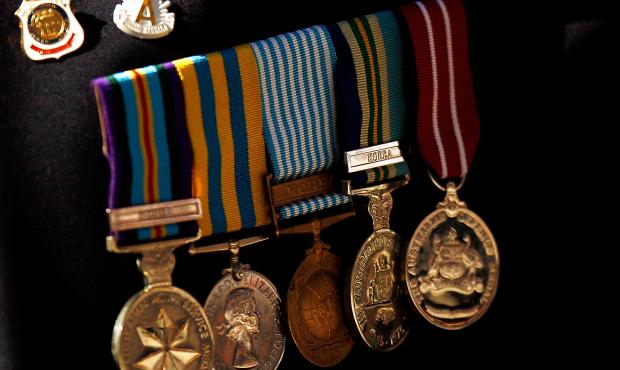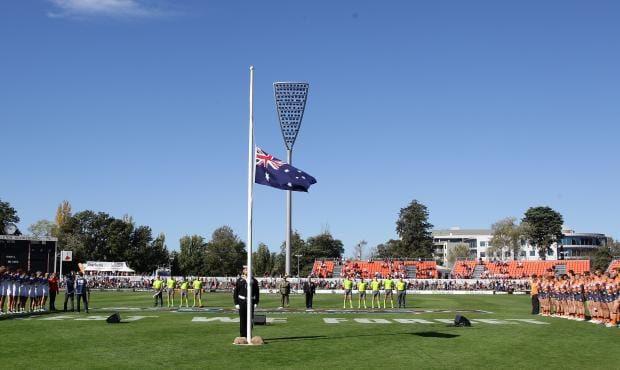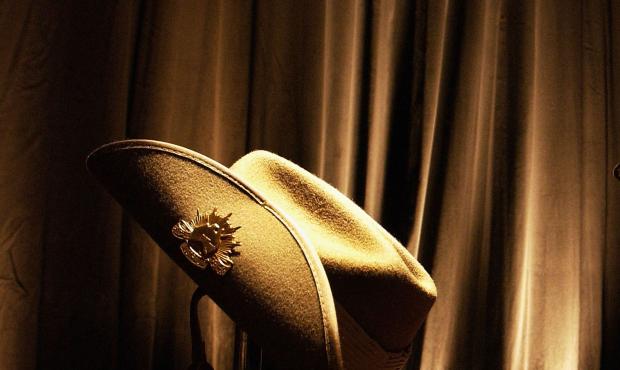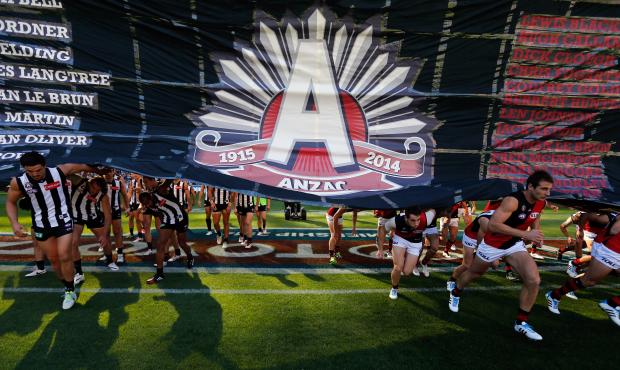• The Carlton and St Kilda players who debuted together and fell on the same day at Gallipoli
• Check out more great stories at the 2015 Anzac Day round hub
IT SEEMS almost inconceivable now, but football and Anzac Day weren't always on the same side.
Long before they formed a strong alliance, the AFL/VFL and the Returned and Services League (RSL) shared a long, complicated and occasionally tempestuous relationship.
For decades they had no relationship at all. The law prevented it.
And when they were finally free to fraternise, the League was initially standoffish, as though it didn't know what to make of the occasion, or realise its possibilities.
Thankfully, for the past 20 years the two parties have been making up for lost time, honouring those who have served – including the legendary Anzacs (Australian and New Zealand Army Corps) of World War I – in a way that credits all involved.
And we are all the better for it – as a society, as citizens, and as a game.
Football has become a significant – though obviously secondary – part of Anzac Day, and has also played a role in returning April 25 to its rightful, almost sacred, status on the Australian calendar.
Indeed, footy – through the traditional Essendon-Collingwood blockbuster at the MCG – has helped raise the profile and awareness of Anzac Day. It also raises money for the Anzac Day Proceeds Fund, which provides support to veterans and their families.
On reflection, this profound result was perhaps always possible given it showcased a contest between two of the biggest clubs, in Australia's most passionately supported game, on the nation's biggest sporting stage, and its most patriotic day.
In the process, the game has also become one of the biggest events on the national sporting calendar – some achievement considering the early-season contests obviously aren't finals (though they are played in finals-like atmospheres) and are sometimes contested by teams that won't make the finals.
Given the success of the arrangement, it seems inexplicable that it took 80 years, and a brainwave from a football visionary, for the AFL and the RSL to fully appreciate the impact they could make if they joined forces.
And that impact will be made like never before this Anzac Day, with four games played in four Australian states and another in New Zealand, as part of the AFL’s Anzac round.
This year marks 100 years since Australians (and other Allies, including New Zealanders) stormed the beaches at Gallipoli in Turkey, showing extraordinary courage in the face of overwhelming odds.
Footballers have played their part in all manner of conflicts involving our country, including Gallipoli.
Among the 8709 Australians who died during the disastrous eight-month campaign were at least 89 League players, including six who fell on April 25, 1915.
Wasted opportunities
The first time League football was played on April 25 was in 1914 – a year before the nation-building events that led to it becoming arguably Australia's most important date.
Through design and circumstance, it would be the only time in the League's first 63 seasons that football would be played on April 25.
The next year, 1915, round one was played on Saturday April 24 – the eve of the Anzac landings half a world away.
From the first anniversary in 1916, April 25 became known as Anzac Day.
But there was no football played on the day for 44 years. A government regulation prohibited organised sport on Anzac Day.
It became a public holiday in Victoria in 1926, but back then League games were played only on Saturday afternoons and, owing to fewer teams and fewer rounds, seasons started later than they do now, so the no-sport-on-Anzac-Day edict didn't pose many programming issues for the League.
The only time it disrupted a season was on Saturday April 25, 1953. The League scheduled the opening round for April 18 and gave the entire competition the next weekend off.
It took an act of parliament in October 1958 to lift the ban on Anzac Day sport.
The Anzac Day Act featured two main provisos.
Games couldn't start before 2pm, so they wouldn't encroach upon Anzac Day services and marches (and giving the veterans and spectators enough time to get to the footy!). This also meant newly introduced reserves curtain-raisers could not be played.
Secondly, the competing clubs would have to contribute a percentage of their takings to the Anzac Day Proceeds Fund.
So in 1959 the League finally had the opportunity to stage matches on the consecrated day. Adding to the practicality of it all, it happened to fall on a Saturday.
But a most curious thing happened: the League didn't immediately jump at the chance. This was despite the RSL and the Victorian government being keen for at least one Anzac Day game to be played.
Instead, the League acted as though the ban was still in place, doing exactly as it had done six years earlier by scheduling round one for April 18 and postponing round two until May 2.
In its defence, the League explained that it had formulated the fixture before the legislation came into effect.
The following year, 1960, when the League finally scheduled games for Anzac Day, it attracted a storm of criticism.

"A proper mess"
Initially, four games were to be played on Saturday, April 23, with the remaining two to be played on the Anzac Day public holiday on the Monday.
However, VFL secretary Eric McCutchan emphasised that it shouldn't be viewed as a precedent, as it was only possible because the public holiday fell on a Monday, and it wouldn't be feasible to play games mid-week. (This view was shared by The Football Record's resident columnist ‘Chatterer’.)
The League's first foray into Anzac Day footy became a PR disaster.
Inclement weather resulted in the four Saturday games being washed out. (Until then, League games had been postponed just three times – following the death of King Edward VII in 1910, and after torrential rain in the winters of 1936 and 1939.)
The Victorian Government and the RSL urged the League to play all six games on Anzac Day. It seemed the logical solution, and one that would not further disrupt the season.
The League disagreed, moving the four abandoned games to the following Saturday, and pushing the entire fixture back a week. It was an option that wouldn't even come under consideration today, given commercial and planning issues. Some clubs, the League argued, would struggle to cover their financial commitments if they also had to make a contribution to the Anzac Day Proceeds Fund.
The move was roundly condemned, with prominent football writer Alf Brown suggesting the VFL risked being called the "Very Financial League".
On the front page of The Age's Anzac Day edition, Victorian Premier Henry Bolte denounced the League's decision as "very wrong" because it "made a mockery of the whole thing" and caused "a proper mess".
"The League is looking at the present, but it should be looking into the future," Bolte fumed.
Opposition Leader Clive Stoneham was similarly scathing, labelling the League's stance "a bit mercenary" and "out of keeping with the spirit of Anzac Day legislation".
RSL state president Charles McKay also expressed the veterans' "great disappointment".
The League believed it had been "most unfairly criticised" and pointed out that it was "the only major sporting body to provide entertainment on … Anzac Day".
Those first two Anzac Day games resulted in a four-goal win to reigning premier Melbourne over St Kilda at Junction Oval, and a seven-point victory to Fitzroy over Carlton at Brunswick Street Oval. Not exactly blockbuster material. And the MCG was vacant.

The VFA trumps the VFL
The League seemed a slow learner. It missed another opportunity the next year, 1961, and was trumped by the rival Victorian Football Association (now the VFL).
After initially deciding not to fixture any games on Anzac Day – a Tuesday – the League back-flipped, scheduling Essendon to host Melbourne at Windy Hill, and Richmond against South Melbourne at Punt Road Oval.
The RSL wanted the Demons and Bombers game – between the top and third-placed teams of the previous season respectively – transferred to the MCG. The two clubs backed the proposal, but the League refused to budge.
In the meantime, the VFA smartly relocated its big Sandringham-Moorabbin clash to the vacant MCG.
What's more, the VFA produced what was an extravaganza for the time, with the pre-game entertainment including marching girls and a band playing The Last Post, Reveille and the national anthem, followed by sprint races at half-time.
Although the VFA game attracted just 14,000 people, little brother had shown big brother how to stage such an event. But, inexplicably, it would still take a considerable time for the penny to drop at the highest level.
The VFL would schedule games on Anzac Day most years – including low-drawing representative fixtures in 1962 and 1967 – and usually used the MCG, but rarely showcased blockbuster games. In fact, there seemed little strategic thinking behind the fixturing for the April 25 public holiday, with random contests unsurprisingly failing to harness the power of the occasion.
Hafey provides the spark
It wasn't until the mid-1970s that the juggernaut potential of Anzac Day footy was first realised.
In 1975 Essendon upset Carlton by 17 points at Waverley in front of a then-Anzac Day record crowd of 77,770.
And this was easily surpassed two years later when new Collingwood coach Tommy Hafey tangled, for the first time, with his former club Richmond, which he had led to four premierships and had left in acrimonious circumstances the previous year.
A raucous MCG crowd of 92,436 saw the Hafey-inspired Pies – wooden-spooners the previous year – defeat the emotional Tigers by 26 points.
But there appeared no attempt to maintain this momentum.
Seven years later, in 1984, another classic Anzac Day clash between traditional rivals took place between Collingwood and Carlton at Waverley, when Blues spearhead Warren Ralph missed a shot after the siren to give the Pies a five-point victory.
In 1986 the League experimented by staging an historic double-header at the MCG, with a Melbourne-Sydney clash in the afternoon followed, half-an-hour later, by a North Melbourne-Geelong night match.
Just 40,117 people turned up and it proved a logistical nightmare, so the double-header concept was shelved.
Anzac Day games have been played every year since 1983, but it's only really been since the Essendon-Collingwood clashes of the modern era that the occasion has risen to a realm beyond that of a simple game of footy.

The masterstoke
The game-changer was Kevin Sheedy, the then-Bombers coach. Sheedy has always prided himself on being a lateral thinker and an ideas man – and this one was a beauty.
While pottering around in his garden, where he has done much scheming and dreaming, Sheedy thought back to the day he played against his old mentor Hafey on Anzac Day, 1977.
He also reflected upon how war had touched his own life. Sheedy had a grandfather and an uncle who, between them, served in both world wars. His father had also been in the army.
Sheedy himself completed two years of compulsory national service in the army from 1969-71.
"It had me thinking about the concept of bringing people to the football, and what entices them to come," he once explained in a Sunday Herald Sun column. "How do we grow the game as well as remember an area of society that needs recognition?"
Sheedy then had a vision: honouring Australia's servicemen and women with an Essendon-Collingwood clash at the MCG on Anzac Day.
The Bombers coach orchestrated a meeting between officials from both clubs and the RSL (whose then president, Bruce Ruxton, was a Pies fan), and the rest is history.
Sheedy once told reporters before an Anzac Day game: "In the end we can never match the courage of people who went to war. But we can actually thank them with the way we play this game, with its spirit. We're very, very lucky people in this country."
Both clubs, and their fans, showed their gratitude in the most emphatic fashion for their seminal 1995 clash.
On that sunny Tuesday, the gates had to be closed 40 minutes before game time because the MCG had already filled to capacity. Some 20,000 people had to be turned away.
A crowd of 94,825 – the second-highest home and away attendance in VFL/AFL history –witnessed an epic draw.
Thereafter, the Pies and Dons have virtually owned Anzac Day football.

Build it and they will come
Twenty years on, crowd figures tell a story.
Anzac Day games from 1960-94 attracted average attendances of 36,887. In 24 games at the MCG alone it was 40,195. Since 1995, 20 Collingwood-Essendon clashes have attracted an average of 83,735.
But stats alone don't define its success.
Often the most valuable endorsements are those that come from foes.
Peter FitzSimons – the prolific author who wrote a book on the Gallipoli campaign - isn't exactly a foe, but the Sydneysider was a star in the rival code of rugby union. When FitzSimons attended the 2008 Anzac Day game, he could barely contain his awe for the event.
"(I) have rarely seen something so impressive in the world of sport," FitzSimons wrote in the Sydney Morning Herald.
"As they played The Last Post and the national anthem, the 100,000-strong crowd uttered not a peep, whispered not a murmur. The atmosphere was electric and the general mood in the air one of reverence for the diggers and anticipation of the game to come …
"Somewhere, someone has done a superb job organising that landmark day in Australian sport."
Players love it too.
The greatest Anzac Day player of all, former Essendon captain and now coach James Hird, in his 2006 autobiography Reading The Play, declared Anzac Day "the greatest day to play football apart from the last one in September".
"There's nowhere else I'd rather be," Hird wrote. "It's an awesome experience, genuinely moving, almost spiritual in its weight of sadness and respect you feel for those who didn't return from war, and the families they left behind."
The Collingwood-Essendon game isn't the only one to have built a proud Anzac Day tradition.
Since 1996, Fremantle has regularly hosted the Len Hall Tribute Game on Anzac Day, honouring Western Australia’s last Gallipoli veteran.
St Kilda will play its third successive Anzac Day game in New Zealand, commemorating bonds formed on battlefields, thus adding a further poignant element to the day and making it a broader Anzac tribute.
And ensuring we will never forget the sacrifices of earlier generations.
THE ULTIMATE SACRIFICE
League footballers who died on active service in World War I
| Club | Fatalities |
|---|---|
| University | 19 |
| Melbourne | 15 |
| Carlton | 12 |
| St Kilda | 12 |
| Essendon | 10 |
| South Melbourne | 10 |
| Collingwood | 8 |
| Fitzroy | 8 |
| Geelong | 8 |
| Richmond | 3 |
Note: Of the 89 League players (including former players) who died on active service in World War I, 16 played for two clubs. In those instances, both clubs have been credited.



